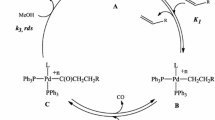Conclusions
-
1.
A comparison of the rates of decomposition through the Menshutkin retro-reaction of triethyl benzyl ammonium chloride and triethyl prenyl ammonium chloride under conditions of interfacial catalysis has shown that the decomposition rate is highly dependent on side reactions of the alkyl halide that is formed, i.e., hydrolysis and alkylation.
-
2.
The alkylation of acetone with triethyl prenyl ammonium chloride in a two-phase alkaline system does not take place within the ion pair Q+A−, but rather as a result of alkylation of this ion pair by free prenyl chloride that is formed by decomposition of the original salt.
-
3.
The observation of an induction period in the alkylation of acetone by prenyl chloride in the presence of triethylamine shows that the amine is not a catalyst, and that its participation in the alkylation process is limited to the formation of a quaternary ammonium ion by interaction with the prenyl chloride.
-
4.
The addition of an equimolar quantity (relative to the ammonium cation) of sodium tetraphenylborate completely stops the alkylation reaction, owing to the formation of the highly lipophilic ion pair R4N+Ph4B−.
Similar content being viewed by others
Literature cited
M. Makosha, Usp. Khim.,46, 2174 (1977).
E. V. Dehmlow, Angew. Chem.,86, 187 (1974).
I. A. Esikova, V. F. Kucherov, B. A. Rudenko, and S. S. Yufit, Izv. Akad. Nauk SSSR, Ser. Khim., 1468 (1978).
A. Weissberger, E. Proskauer, J. A. Riddick, and E. E. Toops, Organic Solvents, 2nd edn., Wiley-Interscience, New York (1955).
M. Finkelstein, R. C. Pedersen, and S. D. Ross, J. Am. Chem. Soc.,81, 2361 (1959).
L. D. Litvinov and B. A. Rudenko, Gas Chromatography in Biology and Medicine [in Russian], Meditsina, Moscow (1971).
V. A. Yakovlev, Kinetics of Enzyme Catalysis [in Russian], Nauka, Moscow (1955), p. 55.
A. T. Babayan, Nina Gambaryan, and N. P. Gambaryan, Zh. Obshch. Khim.,24, 1887 (1954).
G. Wittig, M. Heintzeler, and M.-H. Wetterling, Justus Liebigs Ann. Chem.,557, 201 (1947).
A. T. Babayan, Arm. Khim. Zh.,32, 596 (1979).
Tse-Lok Ho, Synthesis,12, 702 (1972).
K. Williams and B. Holpern, Synthesis,10, 727 (1974).
I. A. Esikova and S. S. Yufit, Izv. Akad. Nauk SSSR, Ser. Khim., No. 11 (1981).
S. G. éntelis and R. P. Tiger, Kinetics of Liquid-Phase Reactions [in Russian], Khimiya, Moscow (1973).
S. D. Ross and M. Finkelstein, J. Am. Chem. Soc.,79, 6547 (1957).
Author information
Authors and Affiliations
Additional information
Translated from Izvestiya Akademii Nauk SSSR, Seriya Khimicheskaya, No. 9, pp. 1996–2001, September, 1981.
Rights and permissions
About this article
Cite this article
Yufit, S.S., Esikova, I.A. Reaction of carbonyl compounds in the presence of phase-transfer catalysts. Russ Chem Bull 30, 1637–1642 (1981). https://doi.org/10.1007/BF00949462
Received:
Issue Date:
DOI: https://doi.org/10.1007/BF00949462




